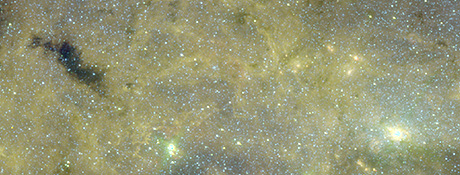A “Cosmic Weather Balloon” at the Centre of the Milky Way
30 September 2013

Photo: NASA/Spitzer/Benjamin et al., Churchwell et al.
The radiation field at the centre of the Milky Way must be 1,000 times stronger than in the area surrounding our sun. Astrophysicists of the “Milky Way Galaxy” Collaborative Research Centre of Heidelberg University used computer simulations to reach this conclusion. The calculations of the researchers from the Centre for Astronomy of Heidelberg University and the Max Planck Institute for Astronomy are based on the data from a type of “cosmic weather balloon” – the temperature data of an especially dense gas cloud near the centre of the Galaxy. Their research provides a new insight into the process of star formation, which is believed to take a different form at the centre of the Milky Way than it does at the Galaxy's edges.
The researchers characterise the centre of our home galaxy as an “inhospitable place”. The “weather conditions” there are reminiscent of those at stormy Cape Horn. While our more distal sun enjoys the conditions of the Galaxy's virtual Italian Riviera, a black hole and extremely hot or exploding stars create an intense “radiation wind” at the Galactic Centre. “In keeping with the metaphor, no one would ever build a ‘vacation home’ somewhere with such harsh conditions. Construction appears to be taking place nonetheless: there are gas clouds near the Galactic Centre where young stars appear to be forming,” says Dr. Paul Clark, a member of Prof. Dr. Ralf Klessen's team at the Centre for Astronomy of Heidelberg University (ZAH).
Dr. Clark and his colleagues studied an especially dense gas cloud called G0.253+0.016 more closely, and in spite of its proximity to the Galactic Centre, a large number of new stars have been observed to be forming there. Star formation is a tug of war between two forces, with gravity pulling interstellar gas inward and the internal pressure of the gas pushing outward. “Near the Galactic Centre, this gas is much hotter than at the edges of the Galaxy due to the strength of the radiation field, leading us to believe that star formation at the centre of the Milky Way differs from how we understand the process at its edges,” explains Dr. Clark.
To better understand the processes at the Galactic Centre, the “weather conditions” there – in this case the strength of the radiation field – need to be determined more precisely. So the researchers used G0.253+0.016 as a type of “cosmic weather balloon”. Astronomical observations were used to determine the temperature of the gas cloud. The data served as a basis for determining the temperature of G0.253+0.016 in relation to the radiation field. The Heidelberg astrophysicists varied the possible strength of this field until the result of the calculations matched the actual temperature measurements. The simulations took advantage of the Jülich-based “Milky Way” supercomputer that is used for projects of the Collaborative Research Centre.
The computer simulations indicated that the radiation field at the centre of the Milky Way must be 1,000 times stronger than in the area around our sun, which is located approx. 25,000 light years away at the Galaxy's edge. The Heidelberg astrophysicists believe that considerably less carbon monoxide (CO) is formed in the extreme conditions in the gas cloud. "Carbon monoxide plays a key role in most star-forming regions, as it helps to regulate the cloud temperatures. The lower CO content in the Galactic Centre clouds will have strong implications for their evolution,“ continues Dr. Clark. Further studies of the “cosmic weather balloon” should provide a complete picture of the star formation process at the centre of the Milky Way.
The results of the research were published in “The Astrophysical Journal Letters”. In addition to Dr. Clark and Prof. Klessen, the research team included Dr. Simon Glover and Dr. Rahul Shetty, as well as Dr. Sarah Ragan from the Heidelberg Max Planck Institute for Astronomy.
Original publication:
P.C. Clark, S.C.O. Glover, S.E. Ragan, R. Shetty and R.S. Klessen: On the Temperature Structure of the Galactic Center Cloud G0.253+0.016, The Astrophysical Journal Letters, Volume 768, Issue 2, article id. L34, 6 pp. (2013), doi: 10.1088/2041-8205/768/2/L34

